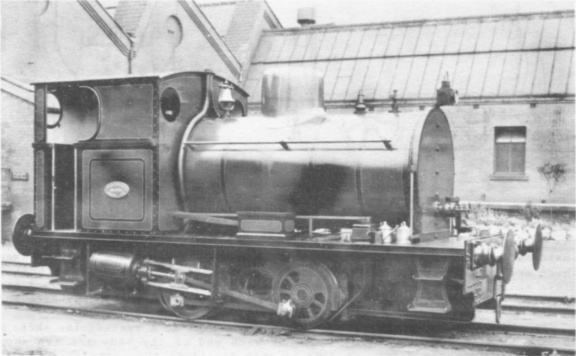
| THE INDUSTRIAL RAILWAY RECORD |
© DECEMBER 1964 |
A SOLO FROM PECKETT
BY
R.W. YateWhen the Co-operative Wholesale Society‘s Irlam Soap, Candle and Starch Works, near Manchester, found another locomotive was needed, they at first envisaged a diesel, but at that time no builder could satisfy their needs with regard to wheelbase, tractive effort, and immediate power. As there were several stationary boilers on the premises it was suggested that an 0−4−0 fireless locomotive be obtained, and this was delivered in 1955 by Irlam‘s traditional builder, Peckett & Sons Ltd. of Bristol, works number 2155. It is unique and represents Peckett‘s one and only entry into the fireless market. In relation to other fireless locomotives its boiler is comparatively snail, but in actual fact is of the same size as those fitted to Irlam‘s more conventional engines, a pair of 1951 Peckett 0−4−0 saddle tanks.
The Fireless managed to perform its duties satisfactorily and proved quite reliable but, owing to its relatively low weight, the tractive effort was limited. Wheel slip easily occurred and only a small number of vans could be moved round the rather sharp curves inside the works. Since most of the curves are left-handed, the tyres wore rather badly on the flanges and had to be changed every two years.

The fireless was still in new condition when photographed by
L. W. Perkins
on 21st August 1955.
The steam reserve of the Fireless, although quite considerable, naturally had a limit, and the receiver pressure had to be watched lest it fall too low for operation at some place remote from the charging point. This was not unknown in the early days and the Fireless had to be towed back for charging at some inconvenience by one of the other engines. One charge was supposed to last four hours, but generally two hours were the limit.
The Fireless was in regular use for internal shunting of vans until early in 1960 when a rearrangement of the works‘ departments resulted in a large reduction in the amount of shunting which needed only one locomotive per day to cope with it. This had to be done by one of the Peckett saddle tank locomotives as one of the remaining duties was the haulage of loaded vans up the steep gradient to the mainline sidings at Irlam station. The small power reserve of the Fireless rendered it unsuitable for this job, and it was taken out of service.
When efforts to dispose of this locomotive proved unsuccessful, consideration was given to the possibility of improving its efficiency by increasing the power reserve, selling one of the saddle tank engines and retaining the second as a spare. The Fireless had shown itself to be an economical proposition and experiments were carried out using compressed air as motive power. A fairly large contractors‘ type of air compressor to charge the steam receiver through a flexible hose was mounted on a flat truck. This most unconventional combination worked much better than expected on the level, but the steep gradient proved to be a major problem. By using a compressor large enough it is clear that this difficulty could be overcome, but the size and cost of the equipment would be considerable. After due consideration it was concluded that this would not be justified under present circumstances, and the Fireless is currently on sale for £500.
When I visited the Works on 23rd September 1962, the large polished brass dome of the Fireless glinted in the sunshine, both it and the other two locomotives being in immaculate condition. They made an ideal picture as they posed outside the half-timbered repair shop amidst the well-kept works gardens and shrubberies.
The leading dimensions of the Fireless locomotive are as under:-
| Wheel diameter | : 2' 9" | Pressure - Charged | : 160 lbs./sq. in. |
| Wheelbase | : 5' 3" | Pressure - Working | : 60 lbs./sq. in. |
| Cylinders - Bore | : 12" | Weight - Empty | : 16 tons |
| Cylinders - Stroke | : 18" | Weight - Full | : 20 tons |
In conclusion, I should like to thank Mr R. Wheaton, Assistant Works Manager at Irlam, for readily providing information for this article.